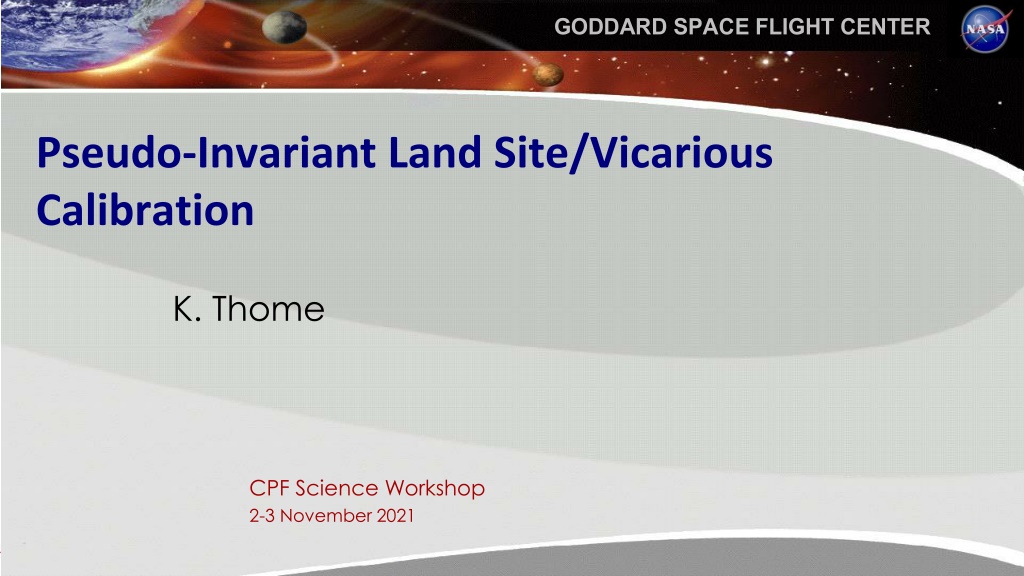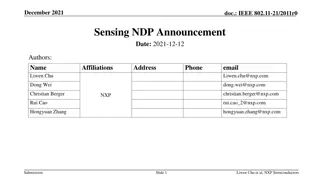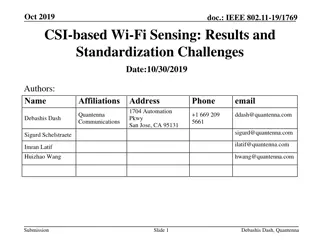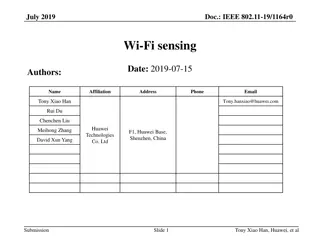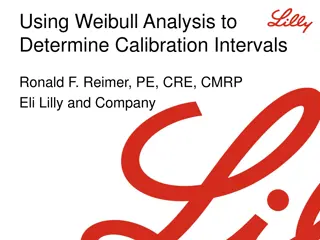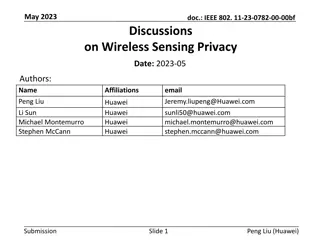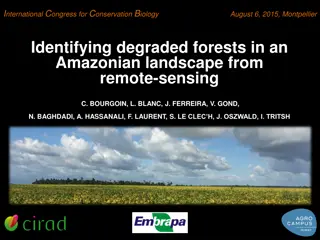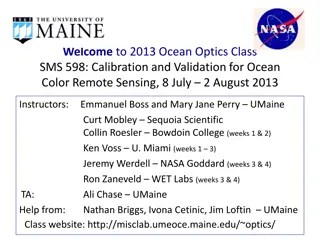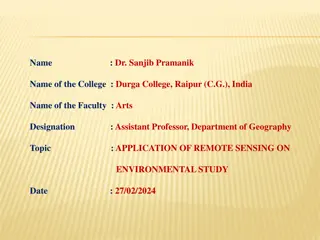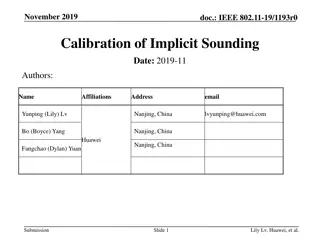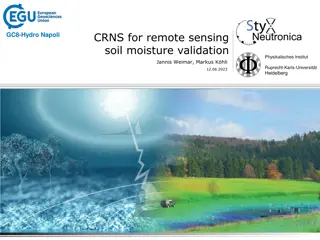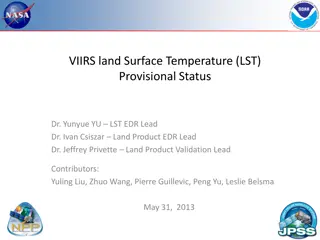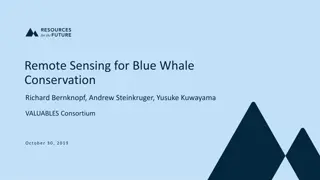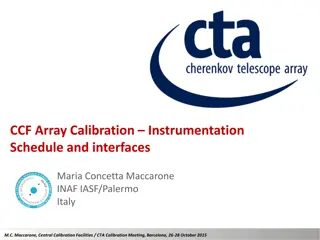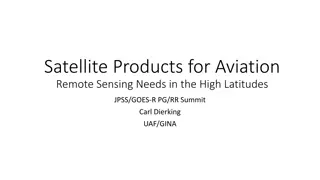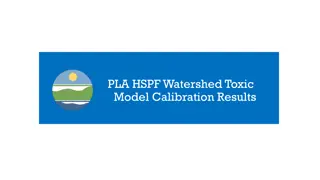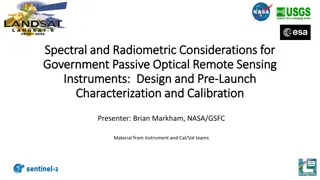Radiometric Calibration Methods for Remote Sensing Applications
Techniques for radiometric calibration in remote sensing include vicarious approaches utilizing invariant desert sites, in-situ methods characterizing surfaces and atmospheres, and SI-traceable measurements for intercomparisons between sensors. The repeatability of in-situ results and comparison with RadCalNet data demonstrate the reliability and accuracy of these calibration methods in ensuring consistent and accurate remote sensing data.
Download Presentation

Please find below an Image/Link to download the presentation.
The content on the website is provided AS IS for your information and personal use only. It may not be sold, licensed, or shared on other websites without obtaining consent from the author. Download presentation by click this link. If you encounter any issues during the download, it is possible that the publisher has removed the file from their server.
E N D
Presentation Transcript
GODDARD SPACE FLIGHT CENTER Pseudo-Invariant Land Site/Vicarious Calibration K. Thome CPF Science Workshop 2-3 November 2021 1
Desert Site L5 Gain Model, IC L5 Gain Model and UAZ Data, Band1 Preflight 1.55 Vicarious approaches 1.5 1.45 Vicarious calibrations are methods that do not use onboard calibration Surface Test sites with and without in situ measurements Modeled atmospheric sources Lunar calibration Deep space views Biggest advantage is that vicarious approaches do not degrade over time Invariant desert sites 1.4 1.35 Cross-calibration points 1.3 1.25 Onboard calibrator results 1.2 Arizona results 1.15 0 5 10 15 20 Time Since Launch [years] RTC Code 2
In-situ based methods Multiple methods but all essentially have the same key pieces Characterize a surface Characterize the atmosphere Radiative transfer model to predict what the sensor sees SI-traceable, absolute radiometric approach Radiative Transfer Code 3
SI-traceability of in situ methods allows for intercomparisons Results shown here are based on RadCalNet RadCalNet (Radiometric Calibration Network) is an automated measurement network through CEOS Show results from three sensors with no coincident views Ratio of RadCalNet top-of- atmosphere reflectance to sensor-based value Uncertainties are combination of systematic and random In situ methods can show real differences between sensors due to differences in atmospheric absorption, view geometries, collection times, and spatial resolution All three agree statistically with each other and with the RadCalNet product 4
Repeatability of in situ results are same order as absolute uncertainty ASTER and ETM+ results in situ based data at multiple sites showing typical scatter in retrieved sensor calibration Error bars are k=1 absolute uncertainty based on SI-traceable error budget Scatter is similar for both sensors Selected ASTER dates are those with ideal measurement conditions 0.95 0 500 1000 1500 2000 2500 3000 1.35 Band 2 - All Dates ASTER 650-nm band all dates 1.30 1.25 1.20 1.15 1.10 1.05 1.00 Band 3 Days Since Launch 1.35 1.70 Band 2 - Select Dates ASTER 650-nm band selected dates 1.30 CPUR (DN/Radiance) 1.65 1.25 1.60 1.20 1.55 1.15 1.50 1.10 1.45 1.05 Landsat 7 ETM+ 650-nm band all dates 1.40 1.00 1.35 0.95 1450 1650 1850 2050 2250 2450 2650 2850 3050 0 500 1000 1500 2000 2500 3000 Days Since Launch Days Since Launch 5
Pseudo-Invariant Calibration Sites (PICS) Surface reflectance does not change significantly with time for PICS Typically desert sites PICS provide large numbers of calibration opportunities Excellent approach for sensor trending Intercomparisons can be done if sensors overlap in time Landsat-7 ETM+ 850-nm band at Libya 4 Libya-4 PICS Libya 4 results from Landsat and Sentinel sensors 6
PICS results benefit from large numbers of collections 100s of data sets needed to understand uncertainties View-sun geometry Spectral Spatial resolution Effects are sensor dependent Using multiple sites helps (and hurts) Landsat-8 OLI 550-nm results from four CEOS PICS Catalogs of PICS are maintained by international calibration groups OLI example for CEOS sites Function of time for 550-nm Yearly trend results for each band for each site Noticeable site-to-site effects Landsat-8 OLI trend studies for CEOS PICS 7
CPF will improve understanding of vicarious uncertainties Validating vicarious approaches requires knowledge of the truth - CPF data will provide truthier data Knowing and attributing uncertainties is more important than calibration Systematic versus random Key to developing improvements CPF s fiducial reference measurements will allow us to decouple effects from Sensor under test Surface Atmosphere Processing approaches and traceability CPF will help understand outliers No singular cause for outlier data sets has been found Results show variability not explained by known uncertainties Radiative Transfer Code 8
Systematic versus random differences RadCalNet results from two sites for blue band of a single sensor Error bars are k=1, SI-traceable, absolute accuracy of RadCalNet product Each data point agrees with sensor s calibration to within combined uncertainties CPF would provide a more stringent comparison to evaluate if there are systematic differences between the two sites No significant temporal change in sensor No significant difference between the two sites 9
Sensor under test effects Cloud-screened results for Landsat 7 and Landsat 8 1600 nm band Data show greater variability for lower SNR system (Landsat 7 whiskbroom scanner) versus higher SNR (Landsat 8 pushbroom) CPF would help understand how much is due to sensor noise 10
Surface effects Same plot as previous chart Data show a seasonal effect that is likely bi-directional reflectance effect caused by changing solar angle CPF would help understand how much is due to sensor noise and how much is the surface 11
Atmospheric effects Same plot as previous chart Scatter in data could be due to sub-pixel clouds, thin clouds, or dust storms CPF would help understand how much is due to sensor noise and how much is the surface and how much is the atmosphere 12
Multiple processing and traceability approaches In situ approaches can follow a radiance-based or reflectance-based traceability Diffuser approach to reflectance-based Absolute radiometric calibration for radiance-based Error budgets show that radiance-based method will have lower uncertainties Diffusers currently a limiting uncertainty for reflectance retrieval Absolute radiometric calibrations have improved dramatically Sampling approaches and ground instrumentation also differ between the two approaches CPF can provide the insight needed to assess the processing, instrumentation, ground sampling, and traceability approaches Radiative Transfer Code 13
Summary CPF will provide data needed to assess and reduce uncertainties in vicarious calibration approaches High accuracy and hyperspectral nature of CPF are the keys to decouple the varied uncertainty contributors in vicarious results Provide a better understanding of test site uncertainties due to atmospheric and surface bi-directional effects Give insight into traceability paths and processing approaches Validated uncertainties will give clear guidance on the difference between noticeable and significant as well as systematic and random Lessons learned will also provide insight into similar effects in higher level data product validation Challenge will be to determine the optimal amount of data needed at vicarious calibration sites 14
GODDARD SPACE FLIGHT CENTER Supporting charts 15
Automated measurements increases number of data points RadCaTS at Railroad Valley Playa, USA Automated field collections have been shown to provide results of similar accuracy as on-site personnel ROSAS at La Crau, France Landsat 8 OLI comparison between automated and on-site personnel approaches 16
Systematic versus random Sensor 1 Sensor 2 RadCalNet results for two sites and two different on-orbit sensors Site A absolute uncertainty (k=1) shown in red and Site B in blue Error bars are standard deviation of average of all points over time Largest disagreements are at 650 nm for both sensors Systematic effect between the sites? If so, what is the cause? CPF would provide one more clue leading to improved site understanding 17
Sensor under test effects Intercomparison between green bands of Terra MODIS and ASTER Same platform Identical views and times Some spectral band differences Top plot is Railroad Valley only while bottom includes multiple CEOS sites Results show degradation of ASTER that is well known Results also variations of several percent that is much larger than can be explained spectral effects Sensor MTF has been shown to improve results but not at the level to account for all differences 1.5 1.45 1.4 1.35 1.3 1.25 1.2 1.15 Sensor cross-calibration with simultaneous view at single site 1.1 1.05 1 0 200 400 600 800 1000 1200 1400 1600 Days since March 1, 2000 1.6 Multiple sites, simultaneous views Calibration Coefficient 1.5 1.4 1.3 1.2 1.1 1 0 200 400 600 800 1000 1200 1400 1600 Days 18
Sensor under test effects Several sensors show much larger standard deviations than can be explained by statistical sampling All sensors show better agreement in NIR All sensors met their absolute radiometric calibration requirement In situ method results for 10 sensors from the EOS era Error bars are standard deviation of average percent difference of reported sensor spectral radiance to predicted vicarious value CPF would help to understand if the NIR agreement is a real effect and whether due to on-orbit sensor SNR, ground-based instrument SNR, smaller atmospheric influences, unknown surface reflectance effect 19
Atmospheric effects Atmospheric effects are not a dominant uncertainty factor at most vicarious calibration test sites High surface reflectance Low aerosol loading Can still be systematic effects Unresolved clouds in sensor under test Aerosol absorption depends on aerosol type CPF s hyperspectral data (and high accuracy) will help to determine impacts from atmospheric uncertainties 20
